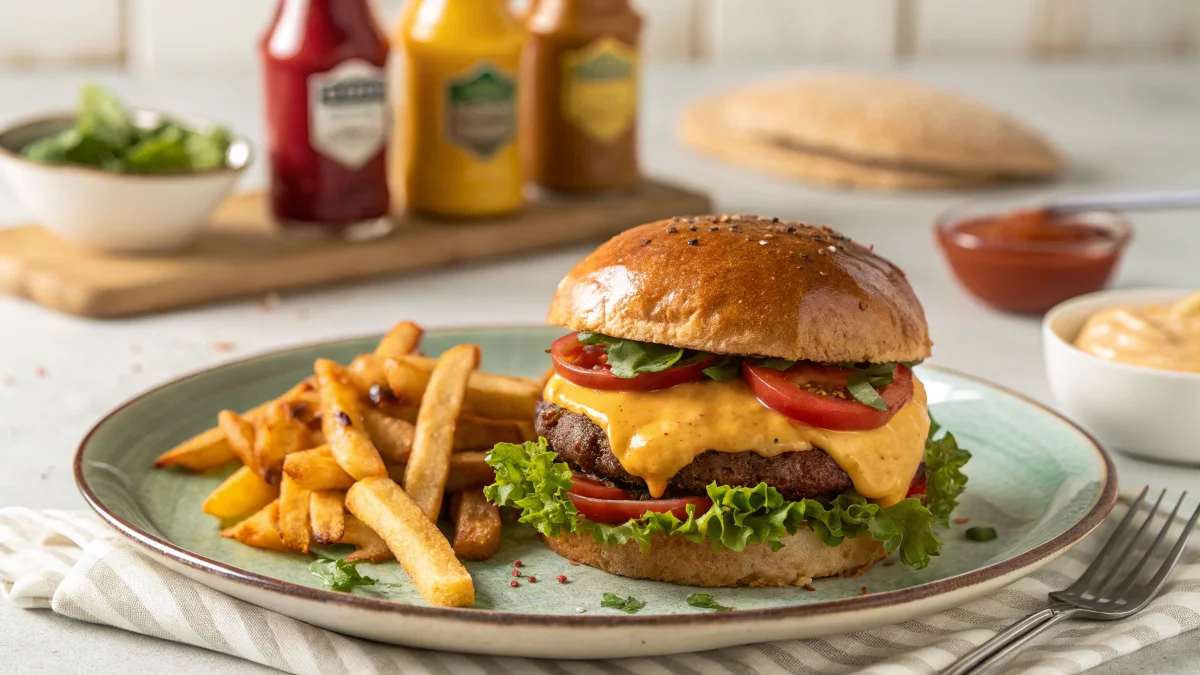Cooking burgers in the oven might seem unconventional, but it’s one of the easiest and most reliable ways to achieve a perfectly cooked patty. Unlike grilling, where temperature control can be tricky, baking allows for consistent heat, resulting in evenly cooked burgers every time. If you’re curious about similar cooking methods for other foods, such as shrimp, check out How Long to Bake Shrimp at 400 Degrees Fahrenheit – Best Tips for Cooking.
This guide will walk you through every step of baking juicy, flavorful burgers in the oven. From choosing the right meat to perfecting the seasoning and learning the exact cooking times for different types of meat, we’ve got you covered.
So, grab your ingredients, preheat that oven, and let’s dive into the art of baking the perfect burger. You’ll discover tips to elevate your burger game, prevent dryness, and impress your family or friends with a meal they’ll rave about!
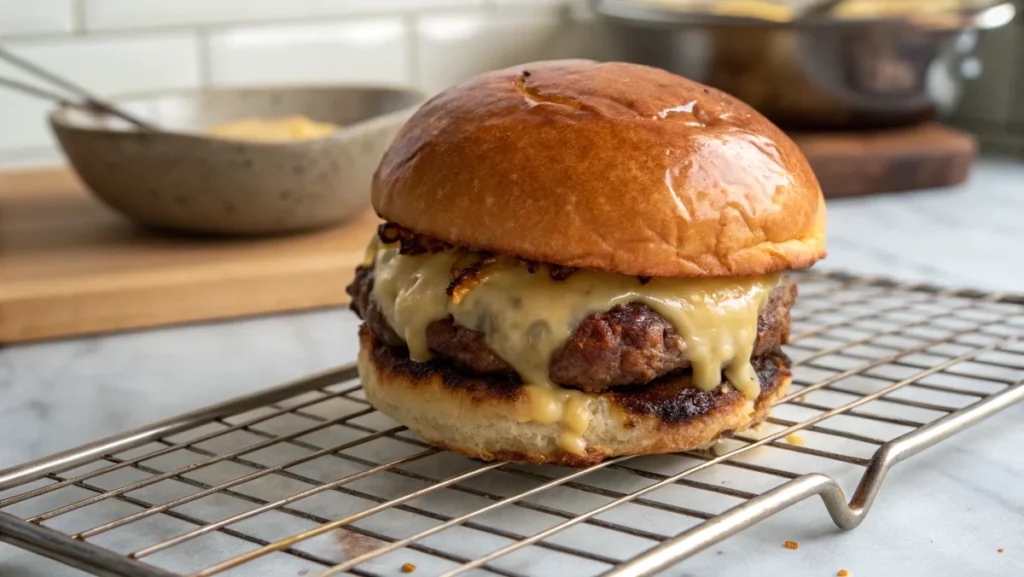
Table of Contents
The Essentials for Oven-Baked Burgers
Choosing the Right Ground Meat (Beef, Turkey, or Plant-Based)
The foundation of a great burger lies in the type of meat you choose. Whether you’re a beef lover or prefer a healthier alternative, the choice of protein affects both flavor and texture:
- Ground Beef:
- Look for an 80/20 blend (80% lean meat, 20% fat) for a juicy, flavorful burger.
- If you prefer a leaner option, consider 90/10, but be aware that it might require extra moisture (like added sauces or toppings).
- Ground Turkey or Chicken:
- These are excellent alternatives for a lighter burger. Choose blends with a little fat to prevent dryness. Adding diced onions or breadcrumbs can help keep turkey burgers moist.
- Plant-Based Options:
- With the rise of vegan diets, plant-based burger patties are more popular than ever. Options like Beyond Meat or homemade black bean patties bake beautifully in the oven.
Must-Have Ingredients for Juicy Burgers
To make oven-baked burgers truly shine, you’ll need more than just meat:
- Seasonings:
- A basic blend of salt, pepper, garlic powder, and onion powder works wonders. For a bolder flavor, try smoked paprika, chili powder, or even a pinch of cumin.
- Binders (Optional):
- While not always necessary for beef, turkey and plant-based patties benefit from added binders like breadcrumbs, egg yolk, or mashed beans to help the patties hold their shape.
- Toppings:
- Classic choices like sliced cheese, lettuce, tomato, and pickles are a must, but don’t shy away from creative options like caramelized onions, avocado slices, or even pineapple rings!
Quick Pro Tip:
For extra juiciness, try mixing a tablespoon of Worcestershire sauce or grated butter directly into the meat mixture before shaping the patties.
Preparing Your Oven for Burger Perfection
Ideal Temperature Settings for Baking Burgers
Achieving the perfect burger in the oven starts with the right temperature. Here’s a quick guide to help you set the stage:
- Standard Baking Temperature:
- Preheat your oven to 375°F (190°C) for a perfectly balanced cook. This temperature ensures your burger cooks evenly without drying out.
- For a Crispier Exterior:
- Opt for 400°F (204°C). The higher temperature gives the edges a slight crust while keeping the inside juicy.
- Broiler Method (Optional):
- If you like a grilled flavor, use your oven’s broiler setting. Place the rack closer to the heat source and cook at high heat for a shorter time, flipping once for even charring.
Prepping Your Baking Sheet or Rack
The way you prepare your baking surface plays a big role in the final result. Follow these tips for mess-free, perfectly cooked burgers:
- Choose the Right Surface:
- Use a baking sheet lined with aluminum foil or parchment paper for easy cleanup.
- For even cooking and better fat drainage, place a wire rack on top of the baking sheet to elevate the patties.
- Grease Lightly:
- While most meats naturally release fat, lightly greasing the rack or paper with cooking spray prevents sticking and ensures smoother handling of patties.
- Spacing is Key:
- Leave at least 1-2 inches between each patty. This allows heat to circulate, ensuring the burgers cook evenly on all sides.
Pro Tip for Even Heating:
Consider preheating the baking sheet before placing the patties on it. A warm surface helps sear the bottoms of the burgers, locking in juices right from the start.
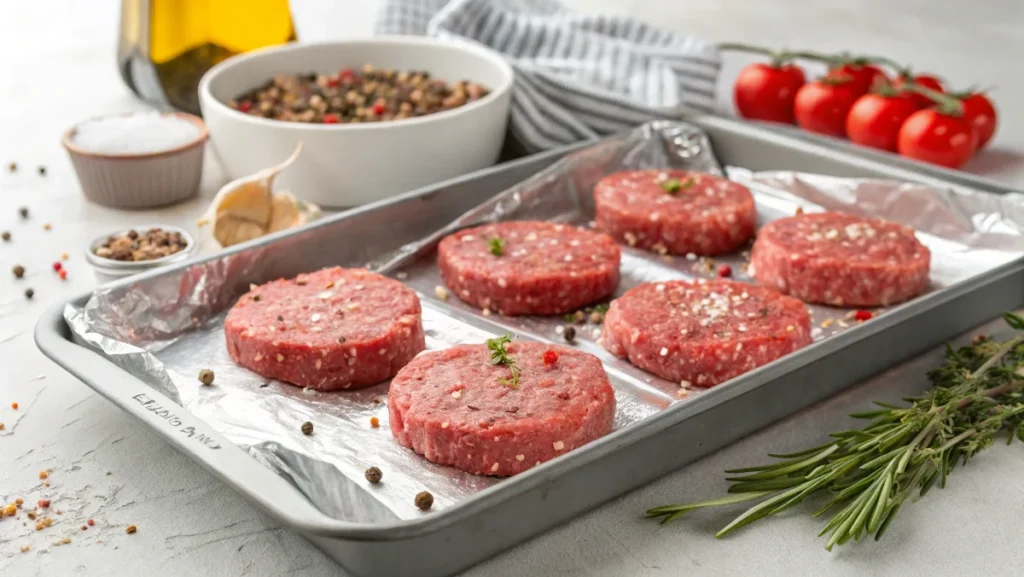
Step-by-Step Guide to Baking Burgers in the Oven
Shaping the Perfect Patty
Creating the right patty shape ensures even cooking and helps avoid a “puffed-up” center:
- Portion Control:
- Use about 4-6 ounces of meat for each patty. A kitchen scale can help maintain consistency.
- Shaping Tips:
- Roll the meat into a ball, then flatten it gently to about ¾ inch thick. Keep the edges slightly thinner than the center to account for shrinkage during cooking.
- Indent the Center:
- Use your thumb to press a shallow indentation in the center of each patty. This prevents the middle from puffing up as the meat cooks.
Tips for Seasoning Burgers Like a Pro
Seasoning is where the magic happens. Here’s how to pack your burgers with flavor:
- Basic Seasoning Blend:
- Sprinkle both sides of the patty generously with salt and pepper.
- Layered Flavors:
- Add garlic powder, onion powder, or smoked paprika for a deeper taste.
- Special Touch:
- If you’re feeling adventurous, mix Worcestershire sauce, soy sauce, or Dijon mustard into the meat before shaping the patties.
Baking Techniques: Covered vs. Open Baking
Depending on your desired result, you can bake burgers uncovered or covered:
- Uncovered Baking:
- Place the patties directly on the baking rack or sheet. This method gives you a slightly crispy exterior, similar to a grilled burger.
- Covered Baking:
- Cover the patties with aluminum foil during the first half of cooking. This traps steam, keeping the burgers extra moist. Remove the foil for the last few minutes for a bit of browning.
Step-by-Step Instructions:
- Preheat Your Oven:
- Set it to 375°F (190°C) or 400°F (204°C) based on your preference.
- Prepare the Baking Sheet:
- Line it with foil or parchment paper and place a wire rack on top. Lightly grease the rack.
- Arrange the Patties:
- Place the shaped patties on the rack, leaving space between each.
- Bake:
- Insert the tray into the middle rack of the oven. Bake for 20-25 minutes, flipping halfway through.
- Check Doneness:
- Use a meat thermometer to ensure proper cooking:
- Medium-rare: 135°F (57°C)
- Medium: 145°F (63°C)
- Well-done: 160°F (71°C)
- Use a meat thermometer to ensure proper cooking:
- Optional Broil:
- For a charred finish, switch to the broiler setting for the last 2-3 minutes.
Pro Tip:
Add cheese during the final 2 minutes of baking. The residual heat will melt the cheese perfectly without overcooking the burger.
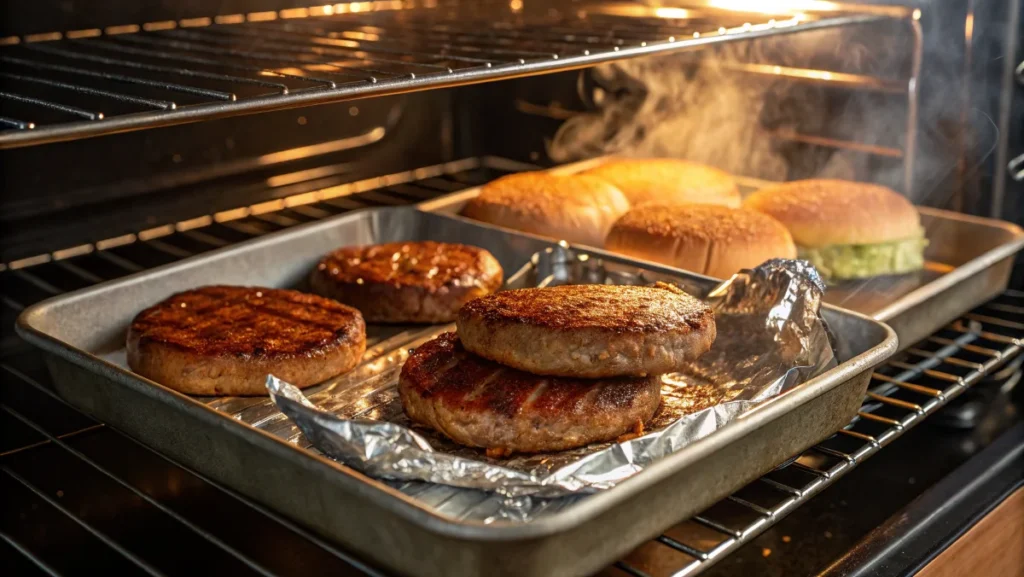
How Long to Cook Burgers in the Oven
Adjusting Cooking Times by Meat Type
Cooking times vary depending on the type of burger patty you’re baking. Follow these general guidelines to ensure every type of patty is cooked to perfection:
- Beef Burgers:
- Medium-Rare: Bake for 18-20 minutes at 375°F (190°C), flipping halfway. The internal temperature should reach 135°F (57°C).
- Medium: Bake for 22-25 minutes, aiming for an internal temperature of 145°F (63°C).
- Well-Done: Cook for 25-28 minutes, with a target temperature of 160°F (71°C).
- Turkey or Chicken Burgers:
- Bake for 22-25 minutes, ensuring an internal temperature of at least 165°F (74°C) for safety. These patties tend to take slightly longer due to their leaner composition.
- Plant-Based Burgers:
- Depending on the brand or recipe, bake for 15-20 minutes, flipping halfway. Check the packaging for exact cooking instructions.
Achieving the Perfect Doneness
To achieve your desired doneness while ensuring the burgers are safe to eat, a meat thermometer is your best friend:
- Insert the Thermometer:
- Insert the thermometer into the thickest part of the patty, avoiding any cheese or toppings that may interfere with an accurate reading.
- Internal Temperature Guide:
- Rare: 125°F (52°C)
- Medium-Rare: 135°F (57°C)
- Medium: 145°F (63°C)
- Well-Done: 160°F (71°C)
- For Turkey or Chicken:
- Always ensure the temperature reaches 165°F (74°C) to prevent any risk of undercooking.
Pro Tips for Consistency:
- Even Thickness:
- Ensure patties are uniformly shaped to avoid overcooking the edges while the center remains underdone.
- Flipping the Patties:
- Flip halfway through cooking to promote even heat distribution. This step is especially important for burgers cooked on a baking sheet.
Common Mistakes to Avoid:
- Overcooking Lean Meats:
- Burgers made with turkey, chicken, or low-fat beef can dry out quickly. Keep a close eye on the cooking time and check the internal temperature.
- Skipping the Resting Period:
- Let your burgers rest for 2-3 minutes after removing them from the oven. This allows the juices to redistribute, keeping the patties moist and flavorful.
Quick Reference Table for Oven-Baked Burgers
| Type of Burger | Temp (°F) | Cooking Time | Internal Temp (°F) |
|---|---|---|---|
| Beef (Medium-Rare) | 375°F | 18-20 mins | 135°F |
| Beef (Medium) | 375°F | 22-25 mins | 145°F |
| Turkey/Chicken | 375°F | 22-25 mins | 165°F |
| Plant-Based Patties | 375°F | 15-20 mins | Per package info |
Tips for Adding Flavor and Moisture
Cheese, Marinades, and Spices
Adding layers of flavor is key to taking oven-baked burgers from good to extraordinary. Here’s how to do it:
- Cheese Selection:
- Add cheese during the final 2-3 minutes of baking for a perfectly melted topping. Popular options include:
- Cheddar: A sharp, bold choice.
- Swiss: Mild with a nutty undertone.
- Pepper Jack: Spicy with a kick of heat.
- Add cheese during the final 2-3 minutes of baking for a perfectly melted topping. Popular options include:
- Marinades:
- For added moisture, marinate your patties before baking. Options include:
- Soy Sauce & Garlic Marinade: A savory boost with umami flavor.
- Barbecue Sauce Marinade: Adds sweetness and tang.
- For added moisture, marinate your patties before baking. Options include:
- Dry Spice Blends:
- Enhance the patties with a dry rub of paprika, chili powder, garlic salt, and black pepper.
Using Foil or Parchment for Extra Juiciness
If you’re worried about your burgers drying out in the oven, here’s a simple fix:
- Wrap in Foil:
- Place the patties on a sheet of foil, add a splash of broth or Worcestershire sauce, and seal the edges to create a moisture-locking packet.
- Use Parchment Paper:
- Lay a sheet of parchment over the burgers while baking to trap natural juices and prevent them from evaporating.
Adding Toppings During Baking
- Veggies:
- Add sliced mushrooms, onions, or bell peppers directly on top of the patties before baking. These will cook alongside the burgers, adding natural sweetness and texture.
- Sauces:
- Spread a thin layer of ketchup, mustard, or barbecue sauce over the patties before the final few minutes of baking for a caramelized glaze.
Pro Tips for Maximum Flavor:
- Butter Hack:
- Place a small piece of butter on each patty before baking. It melts into the burger, keeping it moist and rich.
- Stuffed Patties:
- For a gourmet twist, stuff your patties with cheese, caramelized onions, or sautéed mushrooms before baking.
Avoiding Overpowering Flavors
While bold seasonings and toppings are great, avoid overloading the patties. Let the natural taste of the meat shine by balancing flavors carefully. For those looking to explore other culinary delights, such as sushi, check out this detailed guide on Maki Sushi: Types, Ingredients, Popular Recipes & Health Benefits. It offers insight into the artistry of sushi and tips for creating authentic flavors.
Troubleshooting Oven-Baked Burgers
Avoiding Dry Burgers
One of the most common challenges with oven-baked burgers is preventing dryness. Follow these tips to keep your patties moist and juicy:
- Don’t Overcook:
- Monitor cooking time carefully and use a meat thermometer to check for doneness. Overcooking is the number one cause of dry burgers.
- Add Moisture to Lean Meat:
- Mix in ingredients like grated onions, breadcrumbs, or a tablespoon of mayonnaise to lock in moisture for leaner patties such as turkey or chicken.
- Cover the Burgers:
- Baking burgers with foil or parchment helps retain their natural juices.
- Include Fat:
- If using lean ground beef (90% lean or higher), mix in a little fat such as olive oil or butter to avoid a dry texture.
Common Mistakes to Avoid
- Skipping the Preheat:
- Always preheat the oven before placing your patties inside. A cold oven can lead to uneven cooking and rubbery textures.
- Overhandling the Meat:
- Overmixing or compressing the meat too tightly when shaping patties can result in a dense, tough burger. Handle the meat gently and shape the patties with light pressure.
- Crowding the Baking Sheet:
- Overcrowding prevents even cooking and can lead to steaming instead of baking. Space the patties at least 1-2 inches apart.
- Not Flipping the Patties:
- Flipping the patties halfway through ensures both sides cook evenly and develop a nice color.
Dealing with Undercooked Centers
If your burgers look done on the outside but are undercooked in the center, try these fixes:
- Lower the Oven Temperature:
- Reduce the heat to 350°F (177°C) and cook for a longer time. This allows the patties to cook through without overbrowning the outside.
- Use a Broiler Finish:
- After baking, finish the patties under the broiler for 1-2 minutes to achieve a crispier texture while ensuring the centers are cooked through.
Rescuing Overcooked Burgers
If your burgers come out a bit too dry, you can still salvage them:
- Add a Sauce:
- Serve with a generous topping of barbecue sauce, aioli, or gravy to add moisture back to the patties.
- Top with Juicy Ingredients:
- Add toppings like sliced tomatoes, sautéed mushrooms, or avocado to boost the texture and flavor.
- Make a Burger Melt:
- Turn the patties into a sandwich melt by adding cheese and toasting the burger in a skillet or broiler for a rich and comforting dish.
Pro Tip for Perfect Patties Every Time:
Always let the patties rest for 2-3 minutes after removing them from the oven. This crucial step allows the juices to redistribute, ensuring every bite is juicy and flavorful. If you’re interested in mastering temperature control for other dishes, such as salmon, explore this comprehensive guide on Salmon Internal Temp to achieve perfect doneness every time.
Troubleshooting Oven-Baked Burgers
Avoiding Dry Burgers
- Don’t overcook—use a thermometer for accuracy.
- Add moisture to lean meat with breadcrumbs or onions.
- Cover with foil during baking to retain juices.
Common Mistakes
- Overmixing meat makes burgers tough.
- Crowding the baking sheet leads to uneven cooking.
- Skipping flipping results in unevenly cooked patties.
Fixing Undercooked Centers
- Lower the oven temperature and extend cooking time.
- Finish under the broiler for even cooking.
Saving Overcooked Burgers
- Add sauces like barbecue or aioli for moisture.
- Serve with juicy toppings like tomato or avocado.
Keep these tips in mind for consistently perfect oven-baked burgers!
Pairing Suggestions for Oven-Baked Burgers
Classic Side Dishes
- Fries: Oven-baked fries are a natural match.
- Salad: A fresh green salad adds balance.
- Coleslaw: Creamy and crunchy for a classic pairing.
Perfect Drinks
- Soda: Cola or root beer for a nostalgic vibe.
- Iced Tea: Sweet or unsweetened for a refreshing touch.
- Milkshakes: A diner favorite—choose vanilla, chocolate, or strawberry.
Creative Ideas
- Sweet Potato Fries: Healthier and flavorful.
- Grilled Corn: Adds a smoky, charred element.
- Pickle Spears: Tangy and refreshing.
Quick, simple, and delicious sides make oven-baked burgers shine!
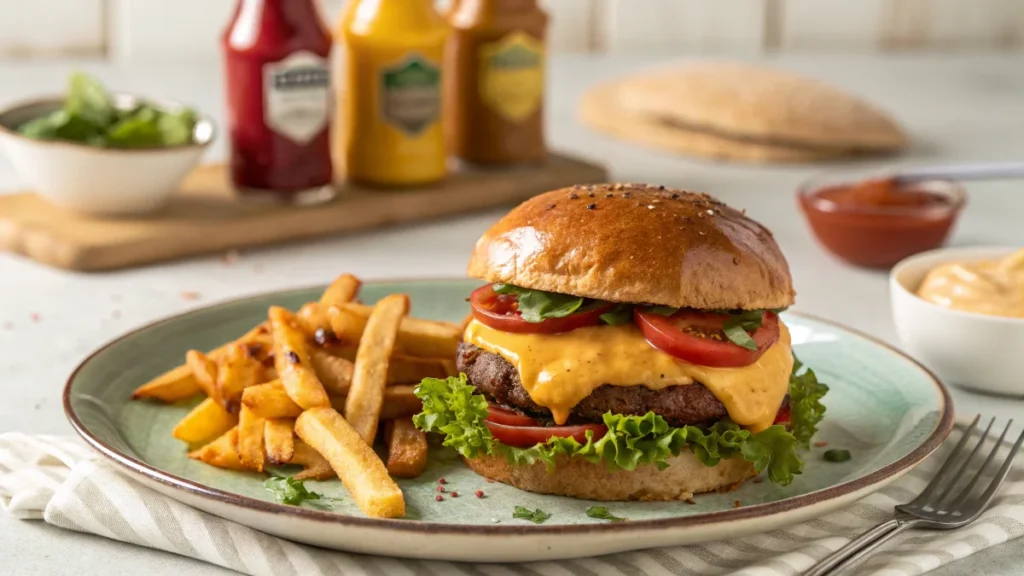
FAQs About Burgers in the Oven
How Long to Cook Burgers at 400 Degrees in the Oven?
Cooking burgers at 400°F (204°C) typically takes 15-20 minutes, depending on the size and thickness of the patties.
- Medium-Rare: 135°F internal temperature, around 15 minutes.
- Medium: 145°F internal temperature, around 18 minutes.
- Well-Done: 160°F internal temperature, around 20 minutes.
To achieve even cooking, flip the burgers halfway through baking.
How Long to Cook Burgers at 350°F?
Burgers cooked at 350°F (177°C) will take slightly longer, around 20-25 minutes.
- Use this lower temperature to ensure a more gradual cook, which is great for lean meats like turkey or chicken.
- Flip the patties halfway for even browning.
- Always use a meat thermometer to check doneness (160°F for beef, 165°F for poultry).
Do You Need to Flip Burgers in the Oven?
Yes, flipping burgers in the oven is recommended for the best results:
- Why Flip?
Flipping ensures both sides cook evenly and develop a slight crust. - When to Flip?
Flip the burgers halfway through the total cooking time. For instance, at 400°F, flip after 8-10 minutes.
If you’re cooking on a wire rack, flipping isn’t as critical because the heat circulates more evenly around the patties.
How Long to Cook Ground Beef in the Oven at 400 Degrees?
Ground beef cooked at 400°F (204°C) typically takes 15-20 minutes, depending on the thickness:
Check that the internal temperature reaches 160°F (71°C) for food safety.
Spread ground beef in a thin, even layer on a foil-lined baking sheet.
Bake for 15 minutes, then stir and continue cooking for an additional 5 minutes, if needed.
Conclusion
Cooking burgers in the oven is an easy, mess-free way to enjoy juicy patties without a grill. By following proper temperatures, flipping for even cooking, and using the right techniques, you can create perfectly cooked burgers every time. If you’re looking for more diverse recipes, consider trying Egg Foo Young, a versatile dish packed with flavor and customizable ingredients.
Give oven-baked burgers a try—they’re simple, delicious, and great for any occasion!

